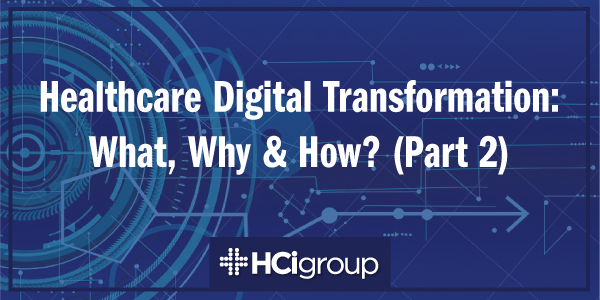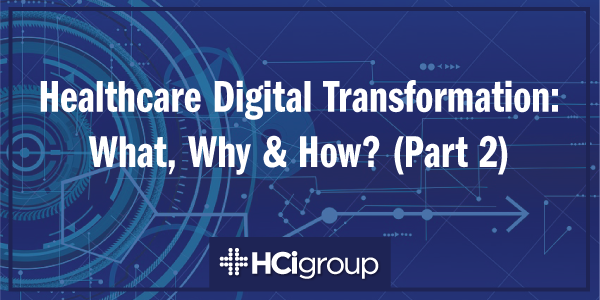Healthcare Digital Transformation: What, Why & How? (Part 2)


This is part 2 of 3 in our "Healthcare Digital Transformation: What, Why & How" blog series. Subscribe to our blog today to be notified when part 3 is released!
Following our recent webinar, The Journey Toward Digital Transformation, we sat down with digital transformation executive, visionary leader and CIO of Children’s Mercy Hospital, David Chou, and HCI Executive Vice President of Technology & Innovation, John McDaniel to respond to questions that were submitted by audience members. The conversation hit on several topics and trends surrounding digital transformation in healthcare.
If you missed the first part of this series, click here to view "Healthcare Digital Transformation: What, Why & How (Part 1)"
How do you evangelize to healthcare executives who are accustomed to fee-for-service, that the success of digital transformation in healthcare goes hand-in-hand with improving patient care?
David Chou
I wish there was a magical answer for that. I would probably be a really rich individual if I could have a solution for that (laughing). The real problem is that 80% of healthcare organizations still operate a fee-for-service model. This means that if you’re a senior leader, the board judges your performance based upon financial metrics. So, what are the balancing acts that you need to play? Do you give up revenue, which may even be profits at times, and take a risk to move toward a transition to value-based care?
What may potentially happen is: you’re operating at a 2% to 3% margin and it takes a few years to start moving your entire operation and your business functions to value-based models. You may not even hit the 2% to 3%, you may only .5% to 1% margin. As a senior leader, do you try to hit .5% or 1% and tell the board that I’m doing the right thing in preparing for the next three to five years for the organization to play in the value-based care game? And because of this, potentially, probably lose your job. Or, do you continue as is – keep moving along at 2% to 3% and sometimes have a good year with good volume, and hit 4% and walk out as a ‘great leader.’
This is a tough balancing act for healthcare executives who know that going toward value-based care is the right thing to do for the patient. But how do you do that when you’re judged so much by the financial aspect? And if you take that gamble, and fail, you may be out of a job. It’s a tough balancing act; I see it across the US, and I don’t know the right answer. I’ve seen a lot of people lose their job because they were trying to do the right thing for value-based care.
John McDaniel
I agree with David. If I had that silver bullet, we wouldn’t be having this conversation now (laughing), because I’d be off enjoying the Mai-Tai’s somewhere.
The way I address it with the C-suite in healthcare is by drawing analogies as to how other companies have transformed over time by utilizing new technologies. I like to use the example of Nokia, which at one point in time owned 90% of the market. Because they really didn’t focus on consumerism and changing their business models, they are barely even in existence today. One of the things that I often say in my presentations, and I don’t think you can print this, is that if you’re a CEO, and a healthcare administrator, you should find another job. We need entrepreneurs in healthcare.
When I’m educating C-suites, I’m trying to encourage them to think as an entrepreneur first. And second, develop a plan to move their organization forward utilizing new care models, value-based care. I encourage organizations to start small and have a health plan and demonstrate that it works; show that you’ve reduced cost, maybe not increased revenue, but certainly increased margins because patients aren’t showing up as often, and they’re taking better care of themselves.
It’s really an approach of education, using analogies to other industries that had similar issues and missed the mark. And more importantly, starting with a specific case like a health plan where you’re already at risk. Because, in my opinion, it’s a risk-based model that drives change and we can move forward with that.
Just to add to what John said – this is where you’re seeing the healthcare industry move toward a lot of mergers and acquisitions, because you can’t do as well without scale. Right now, people are thinking about how to scale to the point in which value-based care makes sense. If you don’t have the scale, it does not make sense and you’re going to lose financially. The model works well if you have a large scale, which is why you’re starting to see the trend toward mergers and acquisitions; people are trying to get that scale so they can prepare for it.
At the same time, if you don’t have that luxury, it’s a very tough balancing act and you need to figure out. As an organization, need to have the end service. John talked about having the payer side, the insurance and the health plan as part of your portfolio and under your organizational umbrella. If you don’t have that, you really can’t participate and it would be very difficult. In addition to having many different entities to provide that whole end-to-end service, you need to have a large scale, where you can have control of the process. This can create that stickiness, so that all the service plans are within your organizational structure. This is how you can really start to think about shifting away from fee-for-service. But without that, it is a very tough act to follow.
John McDaniel
That’s a good point made by David. I don’t know if I ever shared this with you David, but when I was with another organization, I created a model that looked at how many healthcare organizations exist in the United States; there are roughly 5,500, give or take a few. And back to David’s point about mergers and acquisitions, I expect fewer than 1,000 to remain in existence. This is not saying dead, or that the number of beds will go away. This just says the number of names of entities will significantly reduce to less than 1,000.
Healthcare digital transformation often involves an improvement in business process, and the workflow and technology that supports it. What processes are at top of the list for providers, and what technologies are needed to support them?
David Chou
We kind of hit on this already, but I will hit on some specifics. Some specific processes that need to improve are registration, scheduling, pre-registration and bill pay – all the areas that are similar to the self-service feature that we see retail models. We can make reservations at restaurants on an app and pay our bills through apps or through some sort of electronic message. Those are just the basics, I would say, that need to be in place as a foundation for any digital transformation in healthcare.
John McDaniel
I agree with David, but what I would include is that I think every process, as we move down the road toward implementation and better utilization digital health technologies, is going to have impact. As David mentioned, almost every single process that’s in a healthcare organization today, including the development of new care delivery models, will be impacted as we transform digitally.
Because we’re looking at data, we’re looking at the consumer differently and advising them differently. At the end of the day, we may not be treating them differently, but we could be, because we’ve got so much more data that could be predictive in nature. Even if you show up and you’ve got a specific type of tumor, with so much information nowadays, there’s specific technology, processes and drugs that are much more focused because of precision medicine.
I think is going to really, dramatically change every process we have in place today. Starting from the traditional operating processes we talked about. But, more importantly, how do I engage with a consumer in a health setting?
Every process – 90% of the process we have in place today will change. I don’t want to call it an experiment, but it will be an iterative process where we ultimately get it right. The larger the number of organizations that start to drive implementations and utilization of these technologies, can really shorten the whole process if they work together and collaborate.
David Chou
It has to change. Everything must change for it to become that digital world. Right now, every other vertical is going there – healthcare’s next. It’s a matter of new leadership joining organizations and changing that culture, and them agreeing on a vision to transform.
John McDaniel
You’re going back to the point I made earlier. This is why it’s so important to have that roadmap. As we develop the roadmap and put it in place, we will have a better understanding of when we need to define new, or refine existing processes, within a delivery model.
Checkout these recent digitial transformation healthcare blog posts:
- Healthcare Digital Transformation: What, Why & How? (Part1)
- Digital Transformation = Cultural Transformation
- 3 Roadblocks to Digital Transformation
- David Chou on Leading Digital Transformation
To learn more about Digital Transformation and how HCI can support your efforts, please contact us using the button below.

